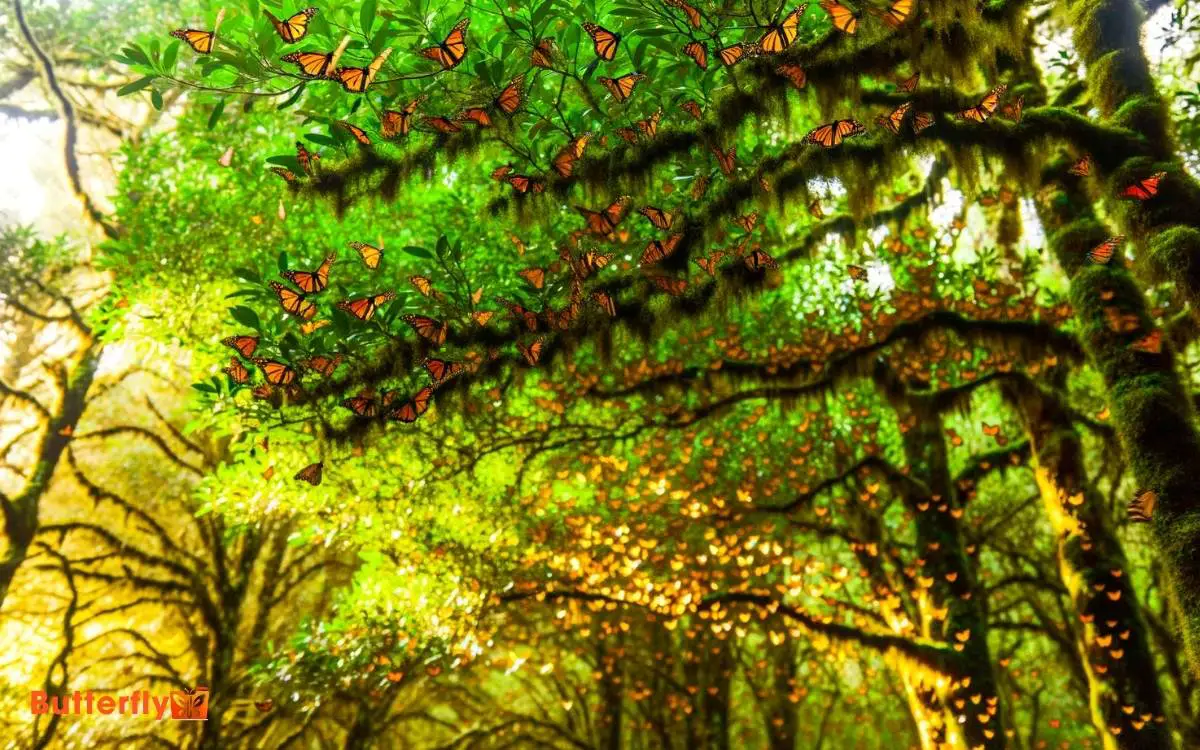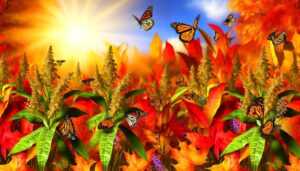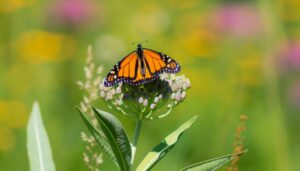Monarch Butterflies on Trees in Mexico: Explore the Routes!
You can witness the awe-inspiring sight of Monarch butterflies clustering on oyamel fir trees in Mexico’s Monarch Butterfly Biosphere Reserve.
These butterflies travel up to 3,000 miles, using environmental cues and Earth’s magnetic field for navigation. They form dense clusters on the trees to conserve energy and stay warm, essential for surviving the winter.
The microclimate of the oyamel forests plays an important role in their survival. Conservation efforts in this reserve focus on combating deforestation and mitigating climate change impacts.
The journey and survival strategies of these Monarchs reveal a fascinating interplay of nature’s cues and behaviors.

Key Takeaways
Migration Journey
Every autumn, millions of monarch butterflies commence on an epic migration journey, traveling up to 3,000 miles from Canada and the United States to the oyamel fir forests in central Mexico.
You’ll observe that these butterflies utilize environmental cues like temperature changes and daylight to navigate. Research shows they possess an innate ability to detect the Earth’s magnetic field, aiding in their remarkable journey.
Monarchs rely on fat reserves accumulated during the larval stage and nectar from flowers along the route. They travel in clusters, sometimes forming dense roosts on trees, which conserves energy and offers protection.
This migration isn’t only a marvel of endurance but also a critical survival mechanism for the species.
Monarch Butterfly Biosphere Reserve
Located in the Trans-Mexican Volcanic Belt, the Monarch Butterfly Biosphere Reserve serves as an important sanctuary for millions of migrating monarchs each winter.
This UNESCO World Heritage site spans approximately 56,259 hectares and includes several core zones and buffer areas.
You’ll find that the microclimate within the reserve, characterized by cool temperatures and high humidity, is essential for monarch survival.
Researchers note that the oyamel fir forests provide the ideal habitat, offering protection from predators and harsh weather. Studies indicate that the aggregation of monarchs on tree trunks and branches helps conserve heat.
Conservation efforts in the reserve focus on mitigating deforestation and promoting sustainable practices to ensure this crucial ecosystem continues to support the monarch population.
Forests of Central Mexico
You’ll find the forests of Central Mexico to be critical habitats rich in biodiversity, where conservation efforts focus on preserving unique flora and fauna.
Seasonal migration patterns of monarch butterflies highlight the interdependence between these forests and the species that rely on them.
Ecotourism in this region bolsters the local economy while promoting environmental stewardship and awareness.
Biodiversity and Conservation Efforts
The forests of Central Mexico, an essential overwintering habitat for monarch butterflies, are the focus of extensive biodiversity and conservation efforts to mitigate the impacts of deforestation and climate change.
You’ll find that initiatives include reforestation projects, such as planting native oyamel fir trees, and enforcement of logging restrictions to preserve these significant ecosystems.
Scientific studies emphasize the importance of maintaining microclimatic conditions within these forests, ensuring the survival of monarch colonies. Researchers also collaborate with local communities, promoting sustainable land-use practices.
Seasonal Migration Patterns
Understanding the monarch butterflies’ seasonal migration patterns to the forests of Central Mexico is crucial for developing effective conservation strategies.
You’ll observe that monarchs undertake a remarkable 3,000-mile journey from North America to these temperate forests each autumn. Research indicates they navigate using a combination of the Earth’s magnetic field and solar cues.
These butterflies cluster on oyamel fir trees, exploiting the microclimate that provides necessary thermal insulation. Scientists have noted a critical link between climatic conditions and migration timing, with temperature shifts influencing arrival and departure.
Monitoring these patterns helps you forecast changes and implement timely interventions. Accurate data collection ensures you can mitigate potential threats to their migratory corridors and overwintering habitats.
Ecotourism and Local Economy
Moreover, Ecotourism in the forests of Central Mexico greatly enhances the local economy by attracting thousands of visitors who are keen to witness the breathtaking monarch butterfly colonies.
When you visit these regions, you’ll observe that local guides play an essential role in managing your experience, providing detailed insights into the monarchs’ life cycle and habitat.
Research indicates that ecotourism generates significant revenue, supporting conservation efforts and providing livelihoods for local communities. By participating in organized tours, you contribute directly to preserving these fragile ecosystems.
Additionally, studies show that sustainable tourism practices help mitigate the environmental impact, ensuring the monarch butterflies continue to thrive.
Your visit not only enriches your understanding but also promotes ecological and economic sustainability in Central Mexico.
Spectacular Clusters
You’ll marvel at the sight of thousands of monarch butterflies clustering together on Oyamel fir trees, creating an awe-inspiring spectacle that has captivated researchers and nature enthusiasts alike.
These clusters aren’t only visually stunning but also an essential part of the monarchs’ survival strategy.
Detailed observations have shown that clustering helps conserve heat and reduce metabolic rates during their overwintering period.
Research highlights three key aspects of these clusters:
- Thermoregulation: Clustering helps maintain ideal body temperatures in the cool mountain air.
- Predator Avoidance: Dense groups can deter predators through sheer numbers.
- Energy Conservation: By reducing individual energy expenditure, monarchs can preserve fat reserves for their spring migration.
Understanding these clusters provides insight into the monarchs’ remarkable migratory journey.
Colors of Monarchs
You’ll observe that Monarch butterflies exhibit vibrant wing patterns, featuring striking orange and black hues that serve both aesthetic and functional purposes.
Research has shown that their coloration changes slightly with the seasons, which may play a role in thermoregulation and mating behaviors.
Additionally, their bright colors act as a warning signal to predators, enhancing their survival through effective camouflage and aposematism.
Vibrant Wing Patterns
The vibrant wing patterns of monarch butterflies, characterized by their striking orange and black coloration, serve as both a warning to predators and a method of camouflage. You’ll find that these colors aren’t just for show.
Monarchs use their bright hues to signal toxicity, thanks to the milkweed they consume during their larval stage. This aposematic coloring deters potential predators.
Research highlights several key functions of these patterns:
- Predator Deterrence: The bright colors indicate the presence of toxic compounds.
- Camouflage: When clustered together on tree trunks, their colors blend into the dappled light.
- Mate Attraction: The patterns aid in identifying and attracting mates.
Seasonal Color Changes
As seasons shift, monarch butterflies exhibit subtle changes in their wing coloration, which researchers attribute to varying environmental conditions and migratory stress.
You’ll notice that during the fall migration, monarchs often display darker wing pigmentation. This increased melanization is believed to enhance thermoregulation during cooler temperatures.
Observations indicate that monarchs with darker wings absorb more sunlight, thereby maintaining ideal body temperatures for flight.
Conversely, in warmer months, their wings may appear lighter. Research suggests that these seasonal color changes aren’t merely aesthetic but are critical adaptations for survival during long migratory journeys.
Camouflage and Survival
Understanding these seasonal color changes offers valuable insights into another critical aspect of monarch butterflies’ survival: their use of camouflage and coloration to deter predators.
You’ll find that monarchs employ their vibrant orange and black hues for more than just aesthetic appeal. These colors serve as aposematic signals, warning potential predators of their toxicity. Research indicates that their bright coloration is an evolutionary adaptation to avoid predation.
To fully appreciate this, consider the following:
- Aposematism: Bright colors signal toxicity, deterring predators.
- Mimicry: Monarchs resemble other toxic species, enhancing their survival chances.
- Seasonal Camouflage: During overwintering, their colors help them blend into the tree bark and foliage.
Survival Strategies
To survive the harsh winter months, monarch butterflies exhibit remarkable migratory behavior and clustering techniques on oyamel fir trees in Mexico.
You’ll notice how they undertake a long-distance migration of up to 3,000 miles, driven by an innate biological clock and environmental cues.
Upon arrival, they form dense clusters on the trees, which helps conserve heat and reduce metabolic rates. These clusters can consist of thousands of individuals, providing mutual insulation against the cold.
Researchers have observed that this behavior minimizes energy expenditure and increases survival rates.
Additionally, the microclimate provided by the oyamel forests offers ideal humidity and temperature conditions, ensuring the butterflies can endure the winter season and emerge ready for reproduction in spring.
Role of Climate
You’ll find that climate plays an essential role in Monarch butterflies’ migration to and from Mexico. Temperature fluctuations directly influence their flight patterns, while specific seasonal weather patterns dictate the timing of their journey.
Research indicates that even slight variations in climate can greatly impact their survival and reproductive success.
Temperature’s Impact on Migration
Fluctuating temperatures greatly impact monarch butterflies’ migratory patterns, altering their timing and routes based on climate variations.
You can observe that as temperatures rise, monarchs initiate migration earlier. This shift can lead to mismatches with their food sources and breeding grounds.
Colder temperatures, conversely, delay their journey, risking exposure to adverse weather conditions.
Consider these critical impacts:
- Phenological mismatches: Early migrations could cause monarchs to miss peak milkweed availability, important for laying eggs.
- Thermal stress: Extreme temperatures can affect metabolic rates, reducing survival rates during migration.
- Habitat shifts: Changing climates may force monarchs to alter their traditional routes, potentially reducing their access to established resting sites.
Understanding these impacts helps in formulating conservation strategies to protect these iconic insects.
Seasonal Weather Patterns
When studying monarch butterflies, understanding how seasonal weather patterns, driven by climate, directly influence their migratory behavior and survival is crucial.
Warm temperatures signal the start of their northward migration, while cooler temperatures trigger their return to Mexico.
Precipitation patterns affect the availability of nectar sources, essential for energy during their long journey. Additionally, wind patterns can either aid or hinder their migration.
| Seasonal Weather Pattern | Effect on Monarchs |
|---|---|
| Warm Temperatures | Initiates northward migration |
| Cool Temperatures | Triggers return to Mexico |
| High Precipitation | Abundant nectar sources |
| Strong Winds | Affects migration routes |
Understanding these patterns helps in predicting migratory behaviors and implementing conservation strategies to protect these butterflies.
Conservation Efforts
Conservation efforts for Monarch butterflies in Mexico focus on habitat restoration, utilizing research-based strategies to combat deforestation and climate change impacts. Scientists and conservationists are working tirelessly to guarantee the survival of these iconic insects.
You can contribute by understanding and supporting these key initiatives:
- Reforestation Projects: Planting native tree species in deforested areas to provide suitable roosting habitats for Monarchs.
- Climate Change Mitigation: Implementing measures to reduce greenhouse gas emissions and monitoring climate patterns that affect butterfly migration.
- Community Engagement: Educating local communities about sustainable practices and involving them in conservation activities to protect Monarch habitats.
Threats to Monarchs
Numerous threats to Monarch butterflies include habitat destruction, pesticide usage, and climate change, each posing significant risks to their survival.
Deforestation in Mexico’s Oyamel fir forests destroys essential overwintering sites. Pesticides, particularly neonicotinoids, contaminate milkweed—their larval host plant—reducing food sources and increasing mortality rates.
Climate change disrupts migratory patterns and breeding cycles. Warmer temperatures can cause premature migration, leading to fatal mismatches between the butterflies and their environment. Extreme weather events, like storms and droughts, further exacerbate vulnerability.
Research indicates that these combined threats could lead to a population decline of up to 57% over the next two decades. Understanding these dangers is essential for developing effective conservation strategies to protect these iconic insects.
Visitor Experience
Visitors to the Monarch Butterfly Biosphere Reserve in Mexico can observe millions of these remarkable insects clustering on oyamel fir trees, creating a stunning natural spectacle.
The experience is immersive and allows for detailed observations of their behavior and migration patterns. You’ll notice the dense clusters formed to conserve heat and the synchronous flight patterns that help dissuade predators.
Here are three key highlights:
- Guided Tours: Expert guides provide scientific insights into monarch biology and their migratory journey.
- Photography Opportunities: Capture breathtaking images of the dense clusters and their iridescent wings.
- Educational Exhibits: Learn about monarch research, conservation efforts, and ecological significance through interactive displays.
This unique experience fosters a deeper understanding of these insects’ remarkable life cycle and migratory phenomenon.
Importance of Protection
Safeguarding monarch butterflies is essential for maintaining their intricate migratory patterns and the ecological roles they play. You need to understand that monarchs contribute significantly to pollination, which supports biodiversity.
Research shows that deforestation and climate change are critical threats to their overwintering habitats in Mexico. By protecting these areas, you help preserve the microclimates these butterflies require for survival.
Conservation efforts, such as reforestation and legal protection of reserves, are important. Scientists recommend reducing pesticide use, as chemical exposure disrupts their life cycle.
You can support these initiatives by advocating for sustainable practices and participating in citizen science projects. Your actions are crucial in ensuring that future generations witness the awe-inspiring phenomenon of monarch migrations.
Conclusion
You’ve witnessed the breathtaking marvel of monarchs clustering on Mexican trees, a phenomenon that’s both a natural wonder and a scientific treasure.
Their vibrant colors, like brush strokes on a canvas, underscore the importance of conservation efforts. Threats loom large, but with diligent protection, you can help guarantee these butterflies continue their epic migration.
By visiting responsibly and supporting preservation initiatives, you’re contributing to a legacy of biodiversity. Don’t let this crucial species flutter into oblivion.






